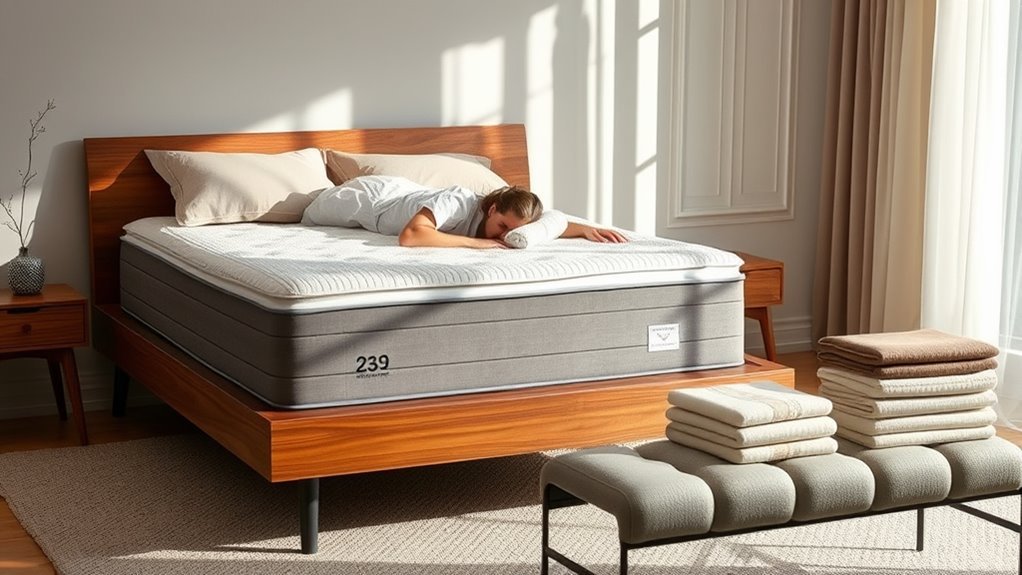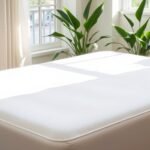When choosing a mattress as a combination sleeper with scoliosis, prioritize medium-firm options that provide both support and cushioning. Look for materials like memory foam or latex that contour to your body, helping to alleviate pain. A hybrid mattress may be ideal due to its adaptability and responsiveness. Test mattresses by lying in your normal positions and consider trial periods for at-home evaluation. Understanding these key factors can greatly enhance your sleep experience moving forward.
Understanding Scoliosis and Its Impact on Sleep
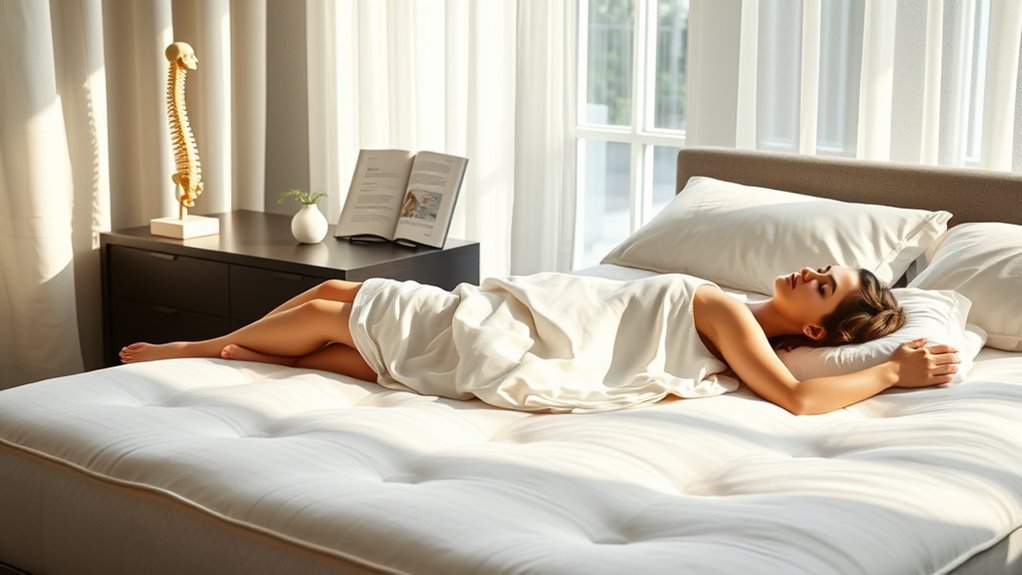
When you have scoliosis, the curvature of your spine can considerably affect your sleep quality and overall comfort. Scoliosis symptoms, such as pain and discomfort, often become more pronounced during sleep, making it essential to find suitable sleep positions that alleviate pressure on your spine. Many people with scoliosis might struggle to find a position that provides both support and relaxation, often leading to restless nights. Side sleeping can be beneficial, particularly with a pillow between your knees to maintain spinal alignment. Back sleeping may also work, provided you use adequate lumbar support. Ultimately, understanding how scoliosis impacts your sleep can empower you to make informed choices, enhancing your overall well-being and freedom during rest.
Key Features to Look for in a Mattress
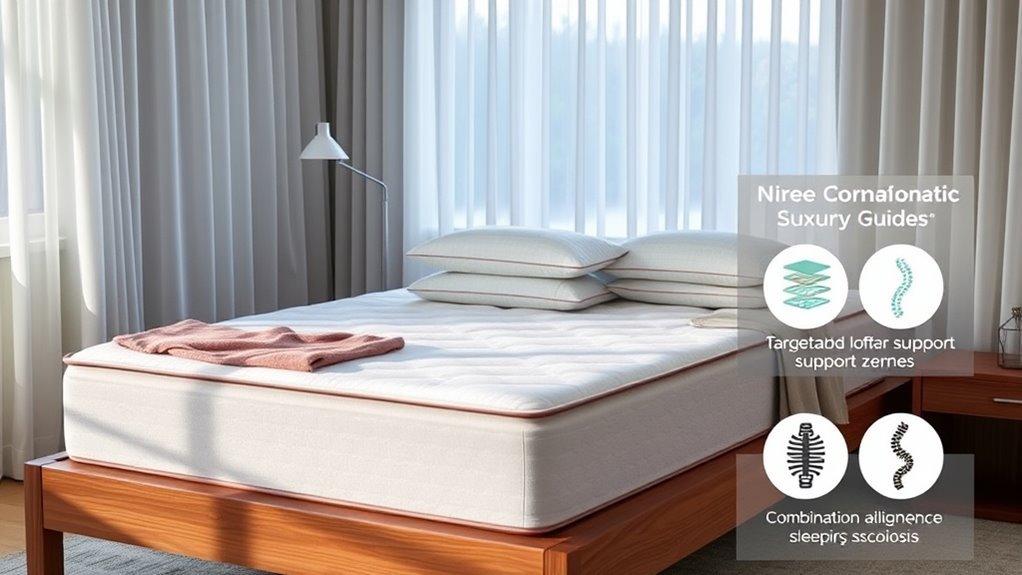
Choosing the right mattress is vital for combination sleepers with scoliosis, as it can greatly influence sleep quality and comfort. When selecting a mattress, focus on key features that accommodate various sleep positions. Look for supportive mattress materials, such as memory foam or latex, which contour to your body while providing necessary spinal alignment. A medium-firm feel is often ideal, offering balance between support and cushioning. Additionally, consider responsiveness; the mattress should adapt easily as you shift positions throughout the night. Breathability is also important to guarantee temperature regulation, enhancing your overall sleeping experience. Ultimately, the right combination of support, comfort, and adaptability will help you achieve restorative sleep, regardless of your preferred sleep position.
Mattress Types and Their Benefits for Combination Sleepers
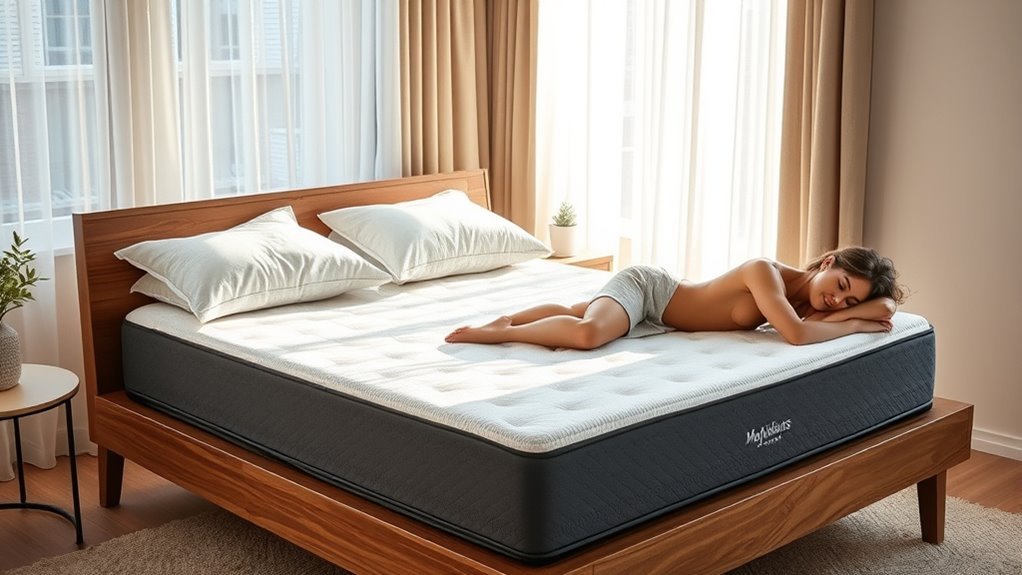
Different mattress types offer distinct advantages for combination sleepers, particularly those managing scoliosis. Memory foam benefits include excellent pressure relief and contouring, which can help align your spine while you change positions. On the other hand, hybrid mattresses combine the support of innerspring coils with the comfort of foam, providing both bounce and cushioning. This blend can cater to your shifting sleep preferences.
| Mattress Type | Benefits |
|---|---|
| Memory Foam | Pressure relief, spinal alignment |
| Hybrid Mattress | Supportive, responsive, adaptable |
| Innerspring | Firm support, good airflow |
Choosing between these options depends on your unique comfort needs and sleeping style, ensuring you find the perfect balance for restful nights.
Firmness Levels and Support Considerations
While many factors influence your mattress choice, firmness level is essential for combination sleepers with scoliosis. Finding the right balance between comfort and support is vital for maintaining spinal alignment. Here are three key considerations for firmness preferences:
- Medium-Firm: Often recommended for its ability to provide both support and cushioning, aligning the spine while alleviating pressure points.
- Adjustability: Look for mattresses that allow you to customize firmness levels, accommodating different sleeping positions and preferences.
- Material Responsiveness: Consider materials that adapt to your body shape without compromising support alignment, ensuring your spine remains properly positioned.
Choosing the right firmness can greatly impact your sleep quality, enhancing overall comfort and support for your unique needs.
Tips for Testing and Selecting the Right Mattress
After determining the ideal firmness level for your needs, the next step is to effectively test and select the right mattress. Start by visiting showrooms to engage in mattress testing; lie down in your typical sleep posture for at least 10-15 minutes. This will help you gauge comfort and support, vital for combination sleepers with scoliosis. Pay attention to pressure points, spinal alignment, and how the mattress adapts as you shift positions. Don’t hesitate to ask about trial periods, as they allow you to evaluate your choice at home. Finally, consider returning options that don’t meet your needs; it’s essential to prioritize your comfort and well-being. A well-selected mattress can greatly enhance your sleep quality.
Frequently Asked Questions
Can a Mattress Help Alleviate Scoliosis Pain?
Yes, a mattress can help alleviate scoliosis pain. Choosing the right mattress firmness is essential for supporting your spine’s natural curvature. A medium-firm mattress often strikes the balance needed for spinal alignment, providing adequate support without causing pressure points. It can adapt to your body’s contours, promoting better posture while you sleep. Ultimately, investing in a quality mattress tailored to your needs can lead to improved comfort and reduced discomfort from scoliosis.
How Often Should I Replace My Mattress?
Think of your mattress like a trusty pair of shoes; over time, they lose support and comfort. Generally, a mattress has a lifespan of 7 to 10 years. If you’re waking up with aches or feeling lumps, those are clear signs it’s time for a replacement. Regularly checking for sagging or noise can help you assess its condition. Prioritizing your sleep comfort can greatly impact your overall well-being.
Are Adjustable Beds Beneficial for Combination Sleepers?
Yes, adjustable beds offer significant benefits for combination sleepers. They allow you to customize your sleeping position, which can enhance comfort and support throughout the night. With adjustable bed benefits, you can easily switch from back to side sleeping without disturbance. This adaptability can help alleviate pressure points and improve spinal alignment, essential for those who shift positions frequently. Consequently, an adjustable bed can provide the combination sleeper advantages you need for a restful night.
What Is the Best Pillow for Scoliosis Sufferers?
The best pillow for scoliosis sufferers typically combines specific pillow types and support levels tailored to your needs. Consider memory foam or adjustable loft pillows, as they contour to your neck and spine, promoting proper alignment. You’ll want a medium to firm support level to maintain stability while you sleep. Experimenting with various options can help you find the perfect balance between comfort and support, ensuring a restful night’s sleep that honors your spine’s natural curve.
Can Sleeping Positions Worsen Scoliosis Symptoms?
Absolutely, your sleep position can impact scoliosis symptoms. If you’re not mindful of your spinal alignment, you might wake up feeling more discomfort. Certain positions, like sleeping on your stomach, can exacerbate issues by straining your spine. Prioritizing a position that supports your curves—like sleeping on your side with a pillow between your knees—can help maintain alignment and reduce pain. Remember, small adjustments can lead to significant relief while you sleep.

